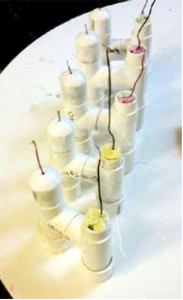Students came up with a great biomimicry example that may actually be relevant to the prototyping aspect of our course. They invented a series microbial fuel cells that they filled with ‘sludge’ from a canal in Brooklyn. When connected they produced enough voltage to power an Arduino board.In their paper «A Biological Imperative for Interaction Design» published at CHI 2013 Amanda Parks and Connor Dickie write:
A societal rethinking around decentralized and distributed models of energy production and distribution brings to light the fact that energy is all around us,
and can be harnessed in small quantities in clever
and seamless ways if properly designed as an integral part of a product, interface, or local infrastructure.
Bio energy has been an underutilized form of readily available energy, harnessed from natural biological processes. The body, an inherit part of any interactive experiences, offers one such source, through its heat
or mechanics, while microorganisms offer another.
For example, microbial fuel cells [Fig 8] are simple devices which generate electrical power by tapping into the metabolic processes of microbes. The conceptual project, Carnivorous Domestic Entertainment Robots [13] [Fig.9] from Auger, Loizeau, and Zivanovic, postulates a future where devices within the home
can power themselves through the breakdown of biological organisms in microbial fuel cells, and in turn, their functionality serves to capture the necessary organisms, thus creating a self-sustaining device.

